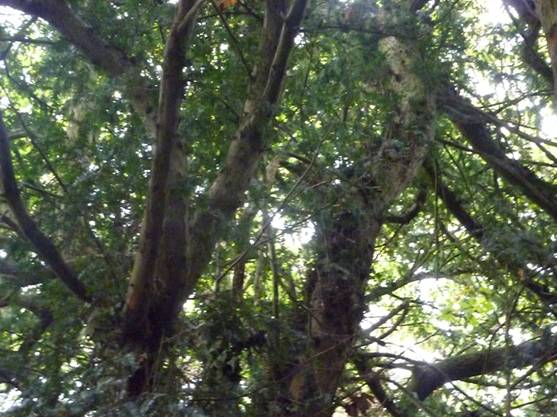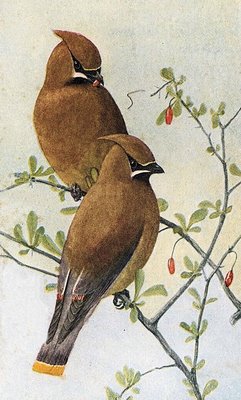
Salty Sam’s Fun Blog for Children
Number 393
City Hedgerows
Hello Everyone

You will remember that Auntie Alice planted a new hedgerow at the bottom of her garden in the spring.
Well, we gave her a lot of help and it took a lot of work to plant it.
Not all the seeds we put in the ground have germinated but a lot of them have. They sprouted over the summer and a lot of them are about a foot tall now.
The seven trees we planted are doing really well.
There are other trees coming on too, but they are much shorter.
And the sloes and holly seeds that are growing will probably never grow to be very tall anyway.
She has been careful to keep all the plants well-watered since they were planted.
All new hedges need watering for the first two years of their life – especially if the summer is very dry.
Her hedge, all in all, is doing very well.
We always think of hedgerows growing around fields. They are often used to keep livestock safely inside their field.
But the countryside is not the only place that hedges can be planted.
City and suburban gardens can offer a huge opportunity to create a network of havens. Hedgerows that support wildlife do not have to be exclusively rural; gardeners can play an enormously important role in providing similar habitats.
The planting of hedgerows create wildlife corridors.
These act to link habitats and enable migration. Animals and insects will travel, meet and breed. The wildlife that lives as a satellite population cannot be self-sustaining long term.
Bees will in a day, often travel up to two miles away from the hive to feed. But when the food supply is difficult to find, they have to use more energy in order to collect the pollen and nectar they need to remain well-fed and, therefore, healthy. These insects play an enormously important role in pollinating our food crops.
Most of our ancient woodlands have disappeared and the animals that used to inhabit them now use hedgerows as their last refuge.
Hedges accommodate a huge percentage of our birds and small mammals. These in turn can be beneficial to gardeners as they eat pests like greenfly and slugs. ln the countryside, infestation of crops can be avoided.
Hedges act as navigation aids and a source of food for bats.
Not everyone has the space to plant a hedge. But planting any plant that supports wildlife is enormously important; creating a service station that will become part of a wildlife corridor facilitating wildlife movement.
Wildlife service stations in gardens can be large or small, mainly native trees or bushes and shrubs. They can also be ponds for frogs, or banks of nectar-rich flowers like lavender.
Plants such as hawthorn or blackthorn provide flowers for insects and berries for birds and can be used to create garden hedges.
Yew berries, as pictured at the top of the post, are very poisonous to animals and humans. Yew trees are often found in church yards where farm animals don’t graze. Yew can be used to make a thick hedge, if the trees are allowed to grow they will grow tall and cast very dense and cool shade in the summer.
Lavender is a good choice for a short, uniform hedge and escallonia for a tall one; they can both live for many years and are loved by bees.
Hedges provide permeable barriers that can diffuse high winds but still offer total privacy. They are preferable to solid walls which can draw winds down into the flowerbeds to cause damage. ln some exposed places, creating a garden without hedge boundaries would not even be possible.
What you ultimately choose to plant will depend on the space you have to fill, the amount of light available, your microclimate and soil type. All have to be considered to give any new hedge, tree or flower garden the best chance of thriving.
Other good plants to choose for wildlife would be: buddleia, cotoneaster, crab apple, dogwood, holly, honeysuckle, hornbeam, ivy, old man’s beard, bryony, wild rose and spindle.
And if a homeowner is looking for extra security for their boundaries then a berberis hedge is so full of sharp thorns no intruder would be able to scale it.
ln order to create the wildlife corridors needed to sustain a healthy ecosystem, lots of people making small additions to their gardens would make a huge difference.
lf you want to plant a hedgerow this winter, you can start collecting seeds now and if they germinate all your plants will be for free. lt is a project that children can take part in – at home or at school.
Children nowadays are more environmentally aware than ever before.
Make sure that you always wash your hands as soon as you come home.
lf you like my blog, please support it by telling all your friends and followers about it.
Thank you!
And see you again next Fun Friday!
Love and kisses
Salty Sam

www.christina-sinclair.com


Bill and Bob’s Joke of the Week![]()
![]()
Bill: You know Bob; you have to be careful when you cross a field because a bull might charge you.
Bob: But what if you don’t have any money on you at the time?

Salty Sam © Christina Sinclair 2015
Unauthorized use and/or duplication of material from this blog without express and written permission from this blog’s author and owner is strictly prohibited.
Links may be used to www.christina-sinclair.com

Picture Gallery
 Sloe
Sloe
 Yew trees can grow to be very old and dense
Yew trees can grow to be very old and dense
 Honeysuckle in a hedge
Honeysuckle in a hedge
 Hedges give wildlife food and shelter
Hedges give wildlife food and shelter

Trees can be left to reach full height in a hedge
and give more living space for wildlife


 THE SALTY SAM NEWS DESK
THE SALTY SAM NEWS DESK

This week, Auntie Alice gave the children their last payment of the summer holidays.
They were very pleased with it and she said she would walk them to the building society in Rocky Bay where they had their savings accounts.
It is very important for everyone to become savers from a very young age.
Once you become a money saver, it can become a habit that can last you for the rest of your life.
If you spend everything you earn and have no savings, you will have no reserves to help you if you suddenly need to buy something expensive or if you have a problem and you need money to help you solve it.
On the way, they met Farmer Jenkins’ children, Jane and Jake who asked them where they were going.
When Bill and Bob told them all about earning extra pocket money, they wanted to do the same thing.
They said that their horse could hold a paintbrush in its teeth and slosh coloured paints onto a big piece of paper.
They thought that maybe they could sell their horse paintings in the farm shop and make money.
Bill, Bill and Emily wished them luck with that and went on their way.


*********************
TO ADVERTISE ON THIS BLOG
PLEASE CONTACT:
christina.sinclair.ads@aol.co.uk
*********************

 Quick Quiz
Quick Quiz
These are trees you find in hedgerows.
Do you know what they are?
- h _ _ _ _ _ _ n
- h _ _ _ _ _ _ m
- b _ _ _h
- f _ _ _ d m _ _ _ e
- r _ _ _ n




lt’s the Weekend!

HOW TO MAKE A SLEEVELESS CARDlGAN FOR A 12” DOLL
This is a really easy pattern for a beginner.
This long cardigan slips easily over many outfits.
BACK (KNIT ONE)
Using 4mm knitting needles and dk yarn cast on 15 stitches
Knit 66 rows of garter stitch
Cast off
FRONT (KNIT ONE)
Using 4mm knitting needles and dk yarn cast on 9 stitches
Knit 66 rows of garter stitch starting with a knit row
Cast off
FRONT (KNIT ONE)
Using 4mm knitting needles and dk yarn cast on 9 stitches
Knit 66 rows of garter stitch starting with a purl row
Cast off
TO MAKE UP
Using over-sew stitching and with right sides together sew up the shoulders by 2cm and side seams 11cm leaving space for arms and neck

Please note that the material on this blog is for personal use and for use in classrooms only.
It is a copyright infringement and, therefore, illegal under international law to sell items made with these patterns.
Use of the toys and projects is at your own risk.
©Christina Sinclair Designs 2015


Quick Quiz Answers
- hawthorn
- hornbeam
- beech
- field maple
- rowan

Rowan


